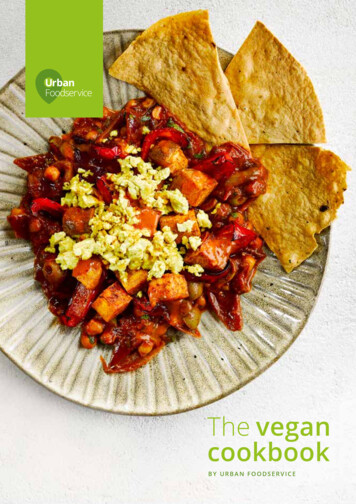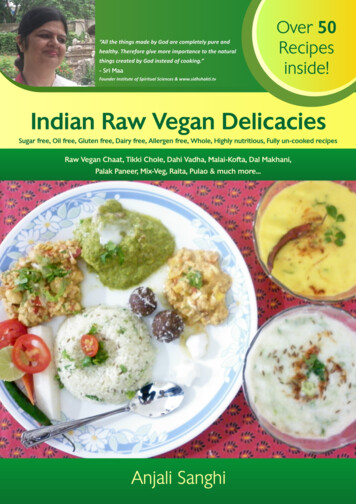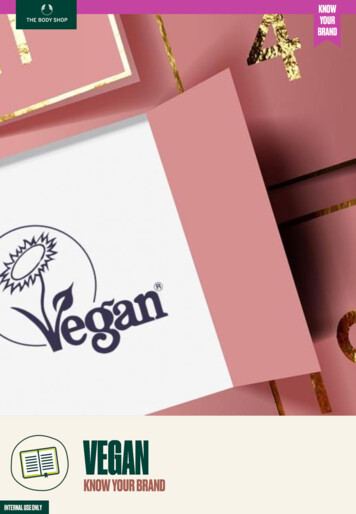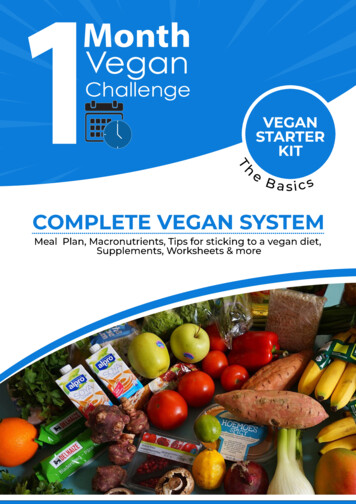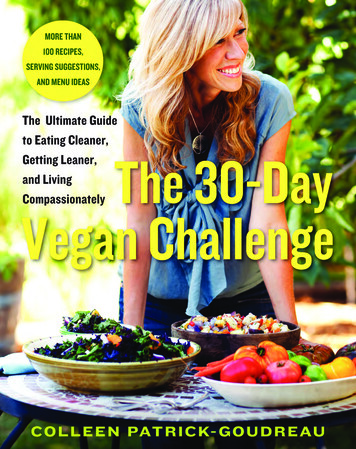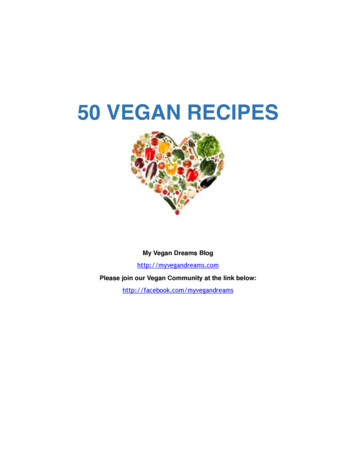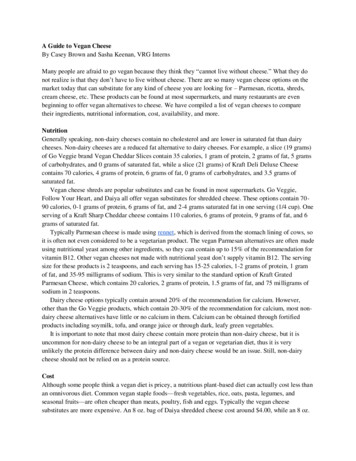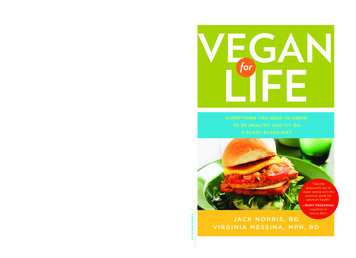
Transcription
Are you already committed to an animal-free diet, but are unclear aboutconflicting advice regarding soy, raw foods, fat, calcium, fish oil, and protein?Have you been hearing too many messages aboutwhat to eat and how to eat it?Vegan for Life is your comprehensive, go-toguide for optimal plant-based nutrition. Registered dietitians and longtime vegans Jack Norrisand Virginia Messina answer all the key questionsand debunk some of the most persistent myths,offering information such as:Vegan for Life is the guide for aspiring and veteran vegans alike, complete with an easy-to-usefood chart, tasty substitutions, sample menus,and expansive resources.“A no-nonsense guide to explode themyths, avoid the pitfalls, and maximizehealth on a plant-based diet. Requiredreading for every vegan, old or new.”—Michael Greger , MD,Director, Public Health and AnimalAgriculture, Humane Society ofthe United StatesJack Norris, RD, cofounder and president of Vegan Outreach, has been elected tothe Animal Rights Hall of Fame. Widely-soughtas a speaker on vegan nutrition, he lives innorthern California.www.VeganHealth.orgISBN-13: 978-0-7382-1493-151700 17.00 / 9.99 / 19.95 CANHealth / DietDa Capo PressA Lifelong OriginalLifelong Books9 780738 214931Norris 9780738214931 cvr r1.indd 1A Member of the Perseus Books Groupwww.dacapopress.comFront cover photograph Louise Lister/StockFoodAuthor photographs: Norris by Kim Sturla; Messina by DejaWebster of Deja View PhotographyEverything YouNeed to Know to BeHealthy and Fit on aPlant-Based DietVirginia Messina , MPH, RD, writesabout vegan and vegetarianism for both consumers and health professionals and serves onthe advisory boards of Vegetarian ResourceGroup and Physicians Committee for Responsible Medicine.www.TheVeganRD.comfor delicious nutrient-dense menus andessential supplements making the transition to plant-based meals the “real deal” about soy and health key nutrition during pregnancy andbreastfeeding how and what to feed vegan kids“Here is the book I have been waiting for!Now when people ask me all those questions about how you can be healthywithout eating animal products, I can tellthem that they will find the answers inVegan for Life.”— P e t e r S i n g e r , author ofAnimal Liberation and Professor ofBioethics, Princeton UniversityVeganVegan LifeAre you considering going vegan,but you’re not sure how to start?NorrisMessinaLifeforEverything You Need to Knowto Be Healthy and Fit ona Plant-Based Diet“Take theguesswork out ofvegan eating with thisessential guide foroptimum health.”—Rory Freedman,coauthor ofSkinny BitchJac k N o r r i s , R DVirginia Messina, MPH, RD4/29/11 11:32:09 AM
9780738214931-text Layout 1 4/12/11 10:23 AM Page iPRAISE FOR VEGAN FOR LIFE“The vegan revolution is upon us! Vegan for Life is an essentialhandbook for understanding all of the ins and outs of this increasingly popular lifestyle choice.”—Mark Reinfeld, coauthor of The 30-Minute Vegan, The 30-MinuteVegan’s Taste of the East, The Idiot’s Guide to Eating Raw, andVegan Fusion World Cuisine“In a clear and concise manner, vegan nutritionists Jack and Virginia spell out what it really means to be healthy. Reading this wellpresented, fact-based book about your well-being and the wellbeing of our planet, you’ll be equipped with all the necessary toolsto achieve your own personal best in health.”—Robert Cheeke, best-selling author of Vegan Bodybuilding & Fitness“Vegan For Life shows not only the adequacy and benefits of a vegandiet, but the steps to make the transition and do it right! It’s thebook I recommend to all of my clients.”—Matt Ruscigno, MPH, RDhttp://avaxhome.ws/blogs/ChrisRedfield
9780738214931-text Layout 1 4/12/11 10:23 AM Page ii
9780738214931-text Layout 1 4/12/11 10:23 AM Page iiiVEGAN FOR LIFE
9780738214931-text Layout 1 4/12/11 10:23 AM Page iv
9780738214931-text Layout 1 4/12/11 10:23 AM Page vVEGANFOR LIFEEverything You Need toKnow to Be Healthy and Fiton a Plant-Based DietUJack Norris, RDVirginia Messina, MPH, RDA Member of the Perseus Books Group
9780738214931-text Layout 1 4/19/11 8:30 AM Page viMany of the designations used by manufacturers and sellers to distinguish theirproducts are claimed as trademarks. Where those designations appear in this bookand Da Capo Press was aware of a trademark claim, the designations have beenprinted in initial capital letters.Copyright 2011 by Jack Norris and Virginia MessinaAll rights reserved. No part of this publication may be reproduced, stored in aretrieval system, or transmitted, in any form or by any means, electronic, mechanical,photocopying, recording, or otherwise, without the prior written permission of thepublisher. Printed in the United States of America. For information, address DaCapo Press, 11 Cambridge Center, Cambridge, MA 02142.Designed by Trish WilkinsonSet in 11.5 point Goudy Old StyleCataloging-in-Publication data for this book is available from the Library ofCongress.First Da Capo Press edition 2011ISBN: 978-0-7382-1493-1E-book ISBN: 978-0-7382-1497-9Published by Da Capo PressA Member of the Perseus Books Groupwww.dacapopress.comNote: The information in this book is true and complete to the best of ourknowledge. This book is intended only as an informative guide for those wishingto know more about health issues. In no way is this book intended to replace,countermand, or conflict with the advice given to you by your own physician. Theultimate decision concerning care should be made between you and your doctor.We strongly recommend you follow his or her advice. Information in this book isgeneral and is offered with no guarantees on the part of the authors or Da CapoPress. The authors and publisher disclaim all liability in connection with the useof this book.Da Capo Press books are available at special discounts for bulk purchases in theU.S. by corporations, institutions, and other organizations. For more information,please contact the Special Markets Department at the Perseus Books Group, 2300Chestnut Street, Suite 200, Philadelphia, PA, 19103, or call (800) 810-4145, ext.5000, or e-mail special.markets@perseusbooks.com.10 9 8 7 6 5 4 3 2 1
9780738214931-text Layout 1 4/12/11 10:23 AM Page viiTo all farmed animals,and to those who work to end their suffering.
9780738214931-text Layout 1 4/12/11 10:23 AM Page viii
9780738214931-text Layout 1 4/12/11 10:23 AM Page ixU CONTENTSIntroduction: Going Vegan for Lifexi1Understanding Vegan Nutrient Needs2Protein from Plants153Vitamin B12: The Gorilla in the Room274Calcium, Vitamin D, and Bone Health375Fats: Making the Best Choices516Iron, Zinc, Iodine, and Vitamin A:Maximizing Vegan Sources617The Vegan Food Guide838Making the Transition to a Vegan Diet1059A Healthy Start: Vegan Diets in Pregnancy andBreast-Feeding13310Raising Vegan Children and Teens14311Vegan Diets for People over Fifty16312Plant Food Advantages:Health Benefits of a Vegan Diet171Managing Weight, Heart Disease, and Diabetes17913ix1
9780738214931-text Layout 1 4/12/11 10:23 AM Page xxContents14Sports Nutrition19515Is It Safe to Eat Soy?20516Why Vegan?217Vegan Resources237A Quick Guide to Cooking Grains, Beans, and Vegetables243Metric Conversion Chart248Acknowledgments249Notes255Index273
9780738214931-text Layout 1 4/12/11 10:23 AM Page xiU INTRODUCTIONGoing Vegan for LifeAvegan diet is the world’s most simple solution to a host of complex problems.For almost all of human history, people ate whatever they could gettheir hands on; availability, habit, and taste preferences were the factors that drove food choices. That changed a mere century or so ago,when the new science of nutrition revealed that food was more thanjust something to eat—it was part of an approach to optimal health.But in the past few decades, we’ve come to understand that whatwe eat has more far-reaching effects. Not just on our health but on thelives of the animals who share this planet with us and on the very future of the planet itself. Our current food system supports a growinghealth crisis in America, a worrisome loss of global resources, andsome of the worst cruelty to animals imaginable. Today, there are a lotof good reasons to embrace a vegan diet.Going vegan is easy and fun. But without a doubt, there is a littlebit of a learning curve. That’s why we wrote this book—to provideboth newcomers and more seasoned vegans with solid informationthat will keep your diet healthy and practical.As dietitians and animal advocates, we are unapologetically provegan, and we want to help as many people as possible take steps toward an animal-free diet. That means that we want you to have thebest nutrition advice possible, because a vegan diet isn’t a realisticchoice if you aren’t meeting your nutrient needs or eating in a wayxi
9780738214931-text Layout 1 4/12/11 10:23 AM Page xiixiiIntroductionthat supports optimal health. We’ll give you all of the basic nutritioninformation—the absolutely essential facts that you need to safeguardyour health while moving toward a vegan diet. We’ve also providedplenty of practical tips and tools to make the transition easy.For those who are new to veganism, we hope the information inthis book will reassure you that a vegan diet is safe and healthy. Butwe think that longtime vegans will find plenty of useful informationhere as well. We’re going to sort through myths that have caused somevegans to make less-than-optimal food choices and give you ideas onhow to make your vegan diet even healthier.And if you are just dipping your toe in the water, that’s fine. Usethe information here to start a transition, because even reducing theamounts of animal foods in your diet makes a big difference.GOING VEGAN IS EASIER THAN EVERVeganism may seem like something new and unusual, but it’s a conceptthat has been around for awhile. In 1944, just after the end of WorldWar II, a small group of British vegetarians added the word “vegan” toour language. It was derived from the first three and last two letters ofthe word “vegetarian” because, they said, “Veganism starts with vegetarianism and carries it through to its logical conclusion.”It was not an easy time to be a vegan, especially in England. Postwarfood shortages made any kind of special diet difficult. The science ofnutrition was young, and some nutrients of specific concern to veganshadn’t even been identified yet. Nobody had ever heard of veganism,so it stands to reason that resources like cookbooks were nonexistent.The change we’re seeing sixty-five years later would have astoundedthose early pioneers. In fact, they astound some of us who have beenvegan for a mere twenty years. Not only do we have hundreds of vegancookbooks, but we also have cookbooks devoted to vegan baking, holiday celebrations, meals for kids, and backyard barbecues. Nearly everygrocery store in America carries soymilk, veggie hotdogs, and dairy-free
9780738214931-text Layout 1 4/12/11 10:23 AM Page xiiiIntroductionxiiiice cream. And if you can’t find what you want in your local market,there are online vegan grocery stores to fill almost every need.All of these changes conspire to make vegan eating easier andmore appealing than you may have ever imagined. Vegans still eatbeans and rice, but they also eat pasta with artichoke pesto, tempehroasted in apricot barbecue sauce, hot fudge sundaes, and veggiecheeseburgers. With better food, more information, and a growing appreciation of the health benefits of plant foods, the world is becomingmore vegan friendly.WHY VEGAN?Since 1950, profound changes have taken place on farms, driven by efforts to cut costs and produce cheap meat, milk, and eggs. The changeshave given birth to factory farms, where animals are crammed intosheds and cages with virtually no room to move. Modern farming ignores the basic instinctual needs and welfare of individual animals.Many die before they ever make it to the slaughterhouse from diseaseor injury or because they couldn’t access food or water. Conditions atslaughterhouses are deplorable and cruel as well. Today’s farm is lesslikely to be a friendly family enterprise and more likely to be a factorywhere efficiency takes precedence over respectful treatment of animals.The plain and simple—and uncomfortable—fact is that production ofanimal foods (even dairy and eggs) contributes to animal suffering.Thanks to the work of animal-rights organizations, more people arebecoming aware of these abuses. One answer for many has been toseek out foods from animals who were raised more humanely. Manyproducts that boast “humanely produced” type labels come from animals who lived under somewhat better circumstances, but often thedifferences are negligible. And all of these animals usually go to thesame slaughterhouses. Likewise, the term “organic” doesn’t translateto “humanely produced.” A large percentage of organic animal foodscome from animals who were raised on factory farms.
9780738214931-text Layout 1 4/12/11 10:23 AM Page xivxivIntroductionAny truly meaningful welfare improvements can take place onlyon very small farms where every phase of the animal’s life (and death)is monitored. But that’s a costly and inefficient way to produce animalfoods. Even if people could afford them, there isn’t enough land forfarms of this type to feed the American population.In Chapter 16, we’ll look at these issues in more depth. It’s not easyto read about the lives of these animals, but if you are wonderingwhether a vegan diet is the right choice for you, we think that the information will provide some perspectives on food choices. Whether youare concerned about the suffering of factory-farmed animals or embracethe belief that animals should never be used by humans, a vegan diet isan effective and meaningful way to put these beliefs into practice.Meat, dairy, and egg production is also wasteful and harmful to theenvironment. Land that is used to raise food for billions of farm animals could grow food for direct human consumption, saving forests,water, and fossil fuels. A reduced dependence on animal foods is a significant step toward making your carbon footprint smaller.Finally, those who opt for a plant-based diet are likely to enjoy personal benefits as well. Vegans have lower cholesterol and less hypertension and are less likely to develop diabetes. And vegan diets havebeen used as part of successful programs for treating chronic disease.We’ll look at those issues in Chapter 13.ARE VEGAN DIETS SAFE?According to the American Dietetic Association, vegan diets are safefor all stages of the life cycle as long as they are well planned.1 The“well-planned” caveat has been a source of annoyance among vegandietitians for nearly two decades. Any diet, vegan or not, has to bewell-planned. Those who consume animal products don’t automatically meet all nutrient needs and can fall short on fiber and othercompounds that are abundant in vegan diets. Likewise, vegan diets require more attention to some nutrients like vitamin B12 and iron.
9780738214931-text Layout 1 4/12/11 10:23 AM Page xvIntroductionxvThe point is that everyone, no matter what type of diet they eat,needs a little nutrition know-how. But yes, vegan diets can—and do—support optimal health throughout the life cycle. Many of the negative stories about vegans, especially children, who suffer from nutrientdeficiencies are actually due to very restrictive types of vegan dietssuch as macrobiotic or raw foods.A vegan diet isn’t difficult; it’s just a different way of meeting nutrient needs. This book is a guide to vegan nutrition and meal planningat all stages of the life cycle as well as for those who wish to adopt avegan diet to reduce their risk for chronic disease. We’ve providedsteps that translate nutrition information into real food choices andrealistic menus for everyone.Going vegan for life is a choice that has win-win written all over it.It respects the lives of animals and represents a refusal to contribute totheir suffering. Many people feel a sense of relief when they start taking steps toward veganism because it reflects how they feel about animals. A plant-based menu is also broadening and will introduce youto new foods and menus; it’s very likely to make your diet more interesting, not less. And depending on what your diet is like right now,making the move toward veganism is very likely to improve yourhealth.This book is for everyone who wants to reap these benefits and isready to get started on the path to compassionate and healthy eating.
9780738214931-text Layout 1 4/12/11 10:23 AM Page xvixviIntroductionU A Few DefinitionsOmnivoreIn this book, we use the terms “omnivore” and “meat-eater” to describeanyone who chooses to include meat and other animal foods in his orher diet. So, an omnivore is someone who eats plants, meat, dairyfoods, and eggs.Plant-based dietsSome omnivores eat a plant-based diet. That is, they eat meat, dairy,and eggs, but they emphasize plant foods in their meals, usually forhealth reasons. The terms “flexitarian” and “semi-vegetarian” are alsoused to describe people who eat this way.Lacto-ovo vegetarianVegetarians who include dairy and eggs in their diet are lacto-ovo vegetarians, sometimes abbreviated as LOV. Historically, most vegetarians inthe United States have eaten this way, and much of what we knowabout vegan diets is actually extrapolated from studies of vegetarians.VeganThe word “vegan” was coined to describe a lifestyle that avoids all animal products for food, clothing, and personal care. It’s based on ethicalconcerns regarding animals. However, a vegan diet—which includes nomeat, fish, dairy, or eggs—is chosen by people for a variety of reasons,including issues regarding animal use as well as health and environmental considerations. Since this is a book about nutrition, when we use theword “vegan,” we are referring to anyone who consumes a diet that includes only plant foods.
9780738214931-text Layout 1 4/12/11 10:23 AM Page xviixviiIntroductionU Our Journeys: How We Became Vegan DietitiansJackI was nineteen years old and went on a fishing trip with my dad andgrandfather. It consisted of putting out a number of lines at the sametime, sitting back, and waiting for one to be tugged on. When a fish wasreeled in, they put the fish in an empty watercooler, where it thrashedaround for a good long time as it suffocated to death. I felt horribleabout it and decided not to reel in any fish. I realized that if the fish werehuman, we would do all we could to save the person from such pain, butsince it was a fish, no one cared. Yet the suffering seemed very similar.My grandfather and father were a bit confused by my reaction. Still, ittook me another two years to stop eating fish!Over the next two years, I read a few pages from Animal Liberation,which one of my philosophy professors showed me, which got me thinking, and then purchased Animal Liberation, which was a benefit albumfor People for the Ethical Treatment of Animals. I wrote to PETA for moreinformation and started to learn about factory farms. The first food Igave up was eggs, followed by mammals and birds. My first couple ofweeks not eating mammals and birds were hard because meat was verytempting, but soon I discovered some high-protein vegan foods and wassatisfied with them. I gave up fish a few months later, and my only animal-product consumption at that point was one glass of cow’s milk eachday for calcium. When my chiropractor told me that I could get calciumfrom greens, I gave up dairy and went vegan in June of 1988.After college, I became a full-time activist for animals, founded VeganOutreach with Matt Ball, and spent two years traveling the country handing out our booklets on veganism to college students. In that time, I cameacross numerous people who said they had been vegan or vegetarianand had not been healthy. Due to this and all the other nutrition issues surrounding a vegan diet, I decided to become a registered dietitian so thatI would know what I was talking about.GinnyWhen I headed off to college to become a dietitian, I was a carefree omnivore, chowing down happily on hamburgers and baked chicken. I’vecontinues
9780738214931-text Layout 1 4/12/11 10:23 AM Page xviiixviiiIntroductionU Our Journeys: How We Became Vegan Dietitianscontinuedloved and felt great compassion for animals all my life, but for two and ahalf decades, it didn’t occur to me that this had anything to do with how Ishould eat.The little light bulb went on over my head just after I obtained my RD.I was newly married and cooking up all kinds of gourmet dinners, including—just for fun—some vegetarian ones. The first vegetarian cookbook I purchased was Laurels’ Kitchen, and I credit it with nudging meonto the path toward ethical eating. Standing in the little kitchen in myapartment in Kalamazoo, Michigan, I opened it and read:This book is dedicated to a glossy black calf on his way to the slaughterhouse many years ago, whose eyes met those of someone who could understand their appeal and inspire us, and thousands of others like us, togive the gift of life.Just like that, something clicked. Those simple words spoke volumes tome, and I knew right then and there that I wasn’t going to eat animalflesh again.Five years later, in 1989, I took a job working for the Physicians Committee for Responsible Medicine and once again made a huge leap inmy understanding of what it means to eat ethically. As the staff dietitian, Idid a lot of reading about dairy and egg production—and what I readabsolutely stunned me. I learned that animals suffer just as much on dairyand egg farms as they do in meat production. I went “mostly vegan” andcontinued to refine my choices over the next several years, eventually removing all animal products from my diet as well as other parts of my life.I also dedicated my work to learning as much as possible about planninghealthy animal-free diets. And my work as a writer and a consultant continues with that focus—sharing information about vegan nutrition andhelping others make a safe and happy journey toward compassionatefood choices.
9780738214931-text Layout 1 4/12/11 10:23 AM Page xixIntroductionU Top Ten Myths about Vegan DietsWhile vegan diets are gaining status more quickly than anyone couldever have imagined, they still sit well outside the mainstream. We have abig challenge in getting the message out that this way of eating is notonly safe and healthful, but enjoyable and realistic too. At the sametime, an enthusiasm for vegan eating among its proponents has givenrise to unfortunate myths that cause some vegans to make poor foodchoices.We’re going to do some myth-busting in this book, and here are tenof the biggest ones that we’ll tackle:1. Vegans need less calcium than omnivores.2. To reap the health benefits of a vegan diet, you need to avoid fat.3. The healthiest vegan diets are based on 100 percent unprocessedwhole foods.4. People don’t need to start taking vitamin B12 supplements until theyhave been vegan for three years.5. If a vegan diet is good, then a raw-foods diet must be better.6. Eating soy gives men female characteristics.7. When you first go vegan, you’ll experience unpleasant feelingsfrom detoxing and withdrawal from animal products.8. Vegan teens are at risk for developing eating disorders.9. Plant proteins are missing some essential amino acids.10. Vegans need to consume only 5 to 6 percent of their calories asprotein.xix
9780738214931-text Layout 1 4/12/11 10:23 AM Page xx
9780738214931-text Layout 1 4/12/11 10:23 AM Page 1CHAPTER1UJUNDERSTANDINGVEGAN NUTRIENT NEEDSNutrition science was born in the early 1800s with the discoveryof protein, carbohydrates, and fats. But long before that, humansknew a lot—strictly through trial and error—about food and healthwithout actually understanding what the protective factors in foods were.The first documented nutrition experiment was performed in 1747by Dr. James Lind, a ship’s doctor with the British Royal Navy. At thetime, being a sailor was a dangerous occupation, not just because ofstorms and piracy, but because as many as half of all sailors who set outon long voyages died from scurvy. Theorizing that it had something todo with the lack of fruits and vegetables on board, Lind fed differentdiets to a small group of sailors and noted that those who consumedlemons and limes didn’t get scurvy.While the navy made good use of the information, ordering allBritish ships to carry limes, the reason that these foods were protectivewasn’t known for another two hundred years when researchers discovered vitamin C. (And while Lind got all the credit for discovering thecure for scurvy, Chinese sailors had been growing greens on their shipsto ward off scurvy since at least the fifth century.)As early as 1916, well before the discovery of many vitamins, nutritionists were recommending intake of certain “protective foods.” Thefirst RDAs were read over the radio to Americans in 1941 and havebeen updated and expanded a number of times since then.1
9780738214931-text Layout 1 4/12/11 10:23 AM Page 22VEGAN FOR LIFEToday, recommendations for individual nutrients are set by theFood and Nutrition Board (FNB) of the National Institute of Medicine. While these are official recommendations, the science behindthem is sometimes still not entirely settled. In some cases, there isn’tenough research for anything more than an educated guess. And actual individual requirements are affected by lifestyle, overall diet, andgenetics, which means that it’s impossible to pin down the exact nutrient requirements of any one person.The recommendations are set at levels that are believed to meet theneeds of the vast majority of Americans. Therefore, for any given nutrient, many Americans will need less than the recommended amountwhile others might need more. There can be exceptions, though. For example, many experts believe that current recommendations for vitamin Dare far too low. And the debate about calcium recommendations is ongoing. We’re also starting to hear questions from world experts about protein requirements; some think that they may fall short of actual needs.1VEGANS AND THE RDASThe dietary recommendations are aimed at omnivores and, in a fewcases, nutrient needs might be higher for vegetarians and vegans. Protein requirements are believed to be slightly higher because plantprotein isn’t digested quite as well as protein from animals. It’s a smalldifference and it’s easily satisfied with vegan diets as long as calorieneeds are met and your diet includes high-protein plant foods. Zincneeds may also be higher, and it’s possible that some vegans have intakes that are less than optimal.The situation for iron is a little more controversial. We’ll see thatvegans have higher requirements but how much higher is a subject ofsome debate. We’ve included the FNB recommendations for iron inthe chart below, but we don’t think that vegans should worry toomuch about getting this much iron. We’ll talk much more about thisissue in Chapter 6.
9780738214931-text Layout 1 4/12/11 10:23 AM Page 3Understanding Vegan Nutrient Needs3NUTRIENT INTAKE OF VEGANS:HOW DOES IT COMPARE TO RECOMMENDATIONS?There isn’t much available information about nutrient intakes of vegans, but a few studies show that vegans are likely to consume more ofcertain nutrients—vitamin C, thiamin, riboflavin, niacin, vitamin B6,folate, and sometimes iron—than omnivores.2 In contrast, many veganshave intakes of calcium and zinc that are lower than the recommendations. In the chart on pages 4 and 5, we’ve compared FNB recommendations to actual intakes of a group of British vegans.GOOD DIETS ARE GOOD ADVOCACYWhether you are already vegan or just starting to take steps in thatdirection, eliminating animal products from your lifestyle is an effective way to make a difference. It reduces animal suffering, removes yourfinancial support for factory farming, and represents a stance againstthe use of animals. But in order to have the greatest impact possible,most of us who care about animals hope to influence others to govegan as well.Those who work for the meat, dairy, and egg industries would like toportray vegan diets as inadequate. So the last thing we want to do isgive them any ammunition. Some vegans balk at the idea of taking vitamin B12 supplements, because they think it makes vegan diets appearinadequate. But taking a chance with nutrient deficiencies is the worstthing we can do for the image of vegan diets. For example, arguing thatvegans have lower calcium needs than omnivores can cause some vegans to make poor choices for their bone health. Taking every precaution to make sure that we are healthy is one way to help others feelconfident about going vegan.Promoting veganism as a lifestyle that is practical, easy, and realisticis important, too. Time, convenience, and taste are primary factors inpeople’s food choices. That’s why overly restrictive diets can create the
Vitamin A, RAE(retinol activityequivalents)Vitamin C,milligramsVitamin D,IUsVitamin E,milligramsVitamin 490090600151201.21.31662 grams0.4 grams per poundideal body 56 gramsWOMENIntakes of British Vegans,2003WOMENVegans0.4 grams per poundideal body weight(or around 60 gramsof protein per dayfor a person whosehealthy body weight is150 pounds)MENRecommended Intakes for Adults0.36 grams per pound 0.36 grams per poundideal body weightideal body weight(or about 54 gramsof protein per dayfor a person whosehealthy body weight is150 pounds.)MENOmnivoresNUTRIENT RECOMMENDATIONS FOR OMNIVORES AND VEGANSCOMPARED TO INTAKES OF BRITISH VEGANS39780738214931-text Layout 1 5/5/11 9:04 AM Page 44
Vitamin B6,milligramsFolate,microgramsVitamin Magne
Vegan’s Taste of the East, The Idiot’s Guide to Eating Raw, and Vegan Fusion World Cuisine “In a clear and concise manner, vegan nutritionists Jack and Vir-ginia spell out what it really means to be healthy. Reading this well presented, fact-based
